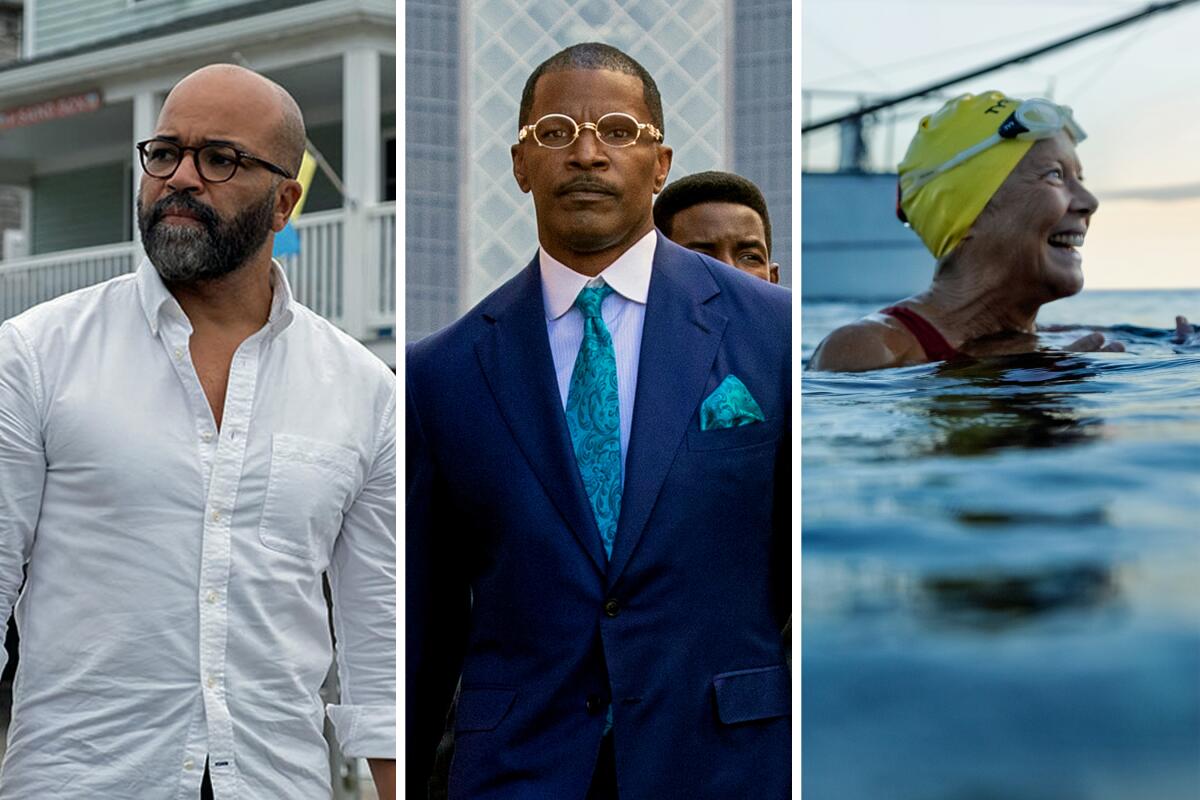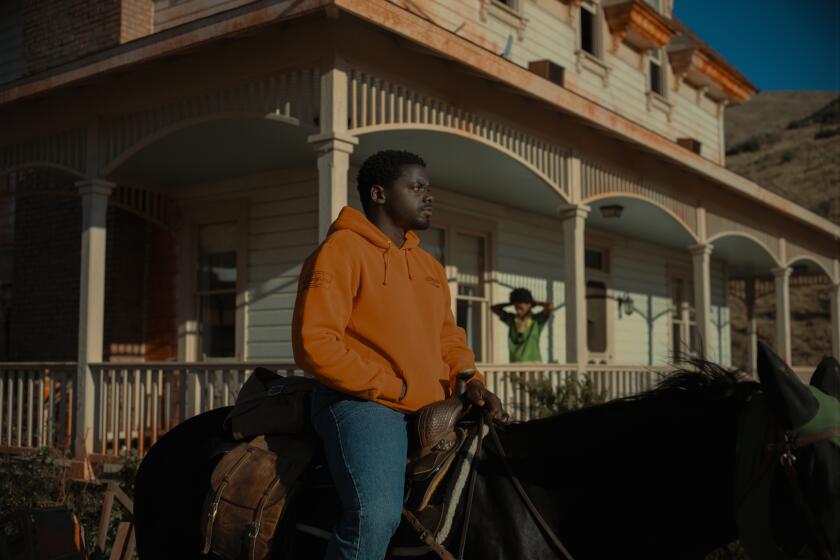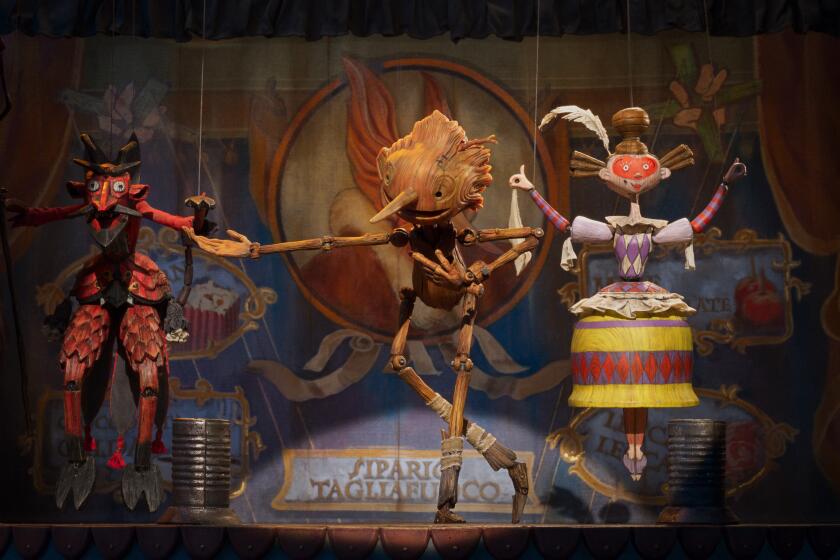Playful and profound, three film scores all help find the truth of the story

- Share via
Some true stories are stranger than fiction, and some stories are blatant fiction — but all of them need music. This year a trio of veteran composers took on three exceptional tales: of an author who exploits the publishing industry by fabricating a memoir that will sell; of a court case ostensibly about a contract dispute but really about the exploitation of a whole community in their time of grief; and of a woman in her 60s attempting to swim from Cuba to Florida. The scores are alternately playful and profound, but all of them are ultimately concerned with the truth.

Laura Karpman
‘American Fiction’
When Laura Karpman first screened “American Fiction” in its rough form, she scream-laughed at one of the film’s fake-out endings. Cord Jefferson directed this adaptation of Percival Everett’s sharply satirical novel, “Erasure” — a story about a novelist, played by Jeffrey Wright in the film, whose books aren’t considered “Black enough” so he responds by adopting a false identity and writing a bald mockery of a genre he believes is exploiting historical pain and stereotypes.
“I loved it on a hundred different levels,” Karpman says. “I loved it because it’s the kind of conversation we need to be having about art, what it is to be an artist, what it is to be identified or judged on what you appear to be rather than what you are — which is, I think, an experience that many, many artists have.”
“Also,” she adds, “it’s just a nuanced and incredible conversation about race in America. And the most radical part of the movie is, of course, the lovely family story.”
Recording with a 70-piece orchestra as well as a group of soloists in Pakistan and India and a choir created a “life-changing recording session,” for the composer.
This medley of topics and disparate tones created an interesting challenge, but Karpman started with the sincere portrait of Monk (Wright) and his family. She had recently lost her father, just like the protagonist in the film, and had acquired his Steinway piano. She started moving her fingers around the ivories just to get a feel for the instrument, and her wife ran in saying, “Press record!”
Karpman had unconsciously wandered into a jazzy, wistful tune that became the family theme. The piano “spoke to me,” she says. “It was very, very weird. It was like my dad was talking to me.”
Like Monk’s family members — who experience sudden loss, estrangement and elder dementia, but also love and laughter — the theme is “very thoughtful, but it’s always out of sync,” Karpman says. It’s generally played by two pianos, or a flute and piano, or guitar and piano, “but they never quite play together.” The exception is when Monk and his brother (Sterling K. Brown) are having fun in a pool, where Karpman turned the theme into a bossa nova.
The composer, who played in jazz clubs when she was studying classical music at Juilliard, was inspired by the character’s namesake — Thelonious Monk — to give him a Monk-like theme, “but one that could also have humor to it,” she says. “So it kind of limps along in 5/4, and it occurs in all these various ways. ... It goes and then it stops, and it goes and stops. But then there are points where it kind of kicks into a nice kind of groove.”
Then there is the film’s dark humor, which Karpman scores with a straight face. She wrote a piece inspired by Maurice Ravel by way of Herbie Hancock for a clever scene where two actors enact characters on the page of Monk’s cynical fake memoir, “My Pafology,” and she wrote a sweeping love cue for the false romantic fade-to-black.
But at the heart of the score is this pensive, jazzy personality — and her father’s piano.
“I was always kind of a weird player,” Karpman says. “But with this piano and this score, I found myself as a pianist. The family theme flowed literally out of my own family. It’s very, very meaningful to me.”

Michael Abels
‘The Burial’
Another film straddling humor and a far deeper story about race is this Maggie Betts adaptation of a 1999 New Yorker article about a real court case where an old white man sued another rich white man over a contract dispute regarding a chain of funeral homes — but both sides hired powerhouse Black attorneys to play to the predominantly Black jury in a small Mississippi courthouse.
Along the way, attorney Willie Gary (Jamie Foxx) uncovers a gross exploitation of Black Southerners by the defendant company, who knowingly gouged them for funeral services.
Betts’ original cut opened on an establishing shot of a tree in a grassy field, which is later revealed to be an unmarked burial ground for America’s enslaved Africans. The director had used an organ performance of Bach’s “Jesu, Joy of Man’s Desiring” under that shot because, to her, it was the sound of a funeral.
And even though that opening shot was eventually replaced, composer Michael Abels developed a main theme in relation to that famous 1723 piece — a series of downward triplets usually sung by noble French horn and representing victory in the halls of justice.
Betts and Abels agreed “The Burial” should have a very classical score, both as a contrast to the ’90s hip-hop tracks littered throughout the soundtrack, and as a way of throwing the audience off balance. It’s a story set in the near-contemporary South, but “once we get there,” says Abels, “it’s a societal dilemma. It’s not just one person versus another.”
Composer Michael Abels has teamed with Jordan Peele three times now. For ‘Nope,’ he used ‘unnerving orchestral techniques’ and a combo of fear and excitement.
Abels came up with a halting woodwind motif that plays during the first act as the case is first explained. It’s a theme “that makes you ask a question,” Abels says. “When you have woodwinds and you have that space between the notes, it kind of makes you go: Huh. Every nugget of information that goes in in the beginning, we need people to keep track of those so that when it all starts to fit together, they’re with us.”
As the next onion layer is peeled, regarding the underhanded deal the funeral corporation made with the Black Baptist church, Abels introduces a mysterious, fizzing waltz motif for piano and harp. That theme, he says, tells us: “We’re getting to the heart of it.”
There are emotional spikes tied to big revelations and jousting on the stand, but mostly this isn’t a conventional courtroom drama. It’s the story of an unlikely friendship that forms between Gary and his client, Jeremiah O’Keefe (Tommy Lee Jones), as well as yet another rotten racist system uncovered almost by accident.
“When you see that people, even in death, are somehow redlined, and their next of kin are exploited,” says Abels, “it’s disheartening, and it’s eye-opening. And so to see the people who were exploited get a chance to clap back is really satisfying.”
The film ends with that shot of the burial ground, tying this recent injustice to an ancient one, and as the credits roll there is a remarkable new arrangement of “Jesu, Joy of Man’s Desiring” by Abels, which interweaves his theme — born in reaction to the Bach — for the movie.

Alexandre Desplat
‘Nyad’
Diana Nyad, at least as she’s portrayed by Annette Bening in the film “Nyad,” is prickly, blunt and something of an egomaniac. She inspires fierce loyalty from her best friend, Bonnie (Jodie Foster), and the navigator (Rhys Ifans) she’s hired to assist on her impossible swim from Cuba to the Florida Keys — even as she barks and bites at them.
One of composer Alexandre Desplat’s tasks was to highlight the softness hiding inside of her.
“I think that anyone that watches the film understands that there is something much softer inside, that’s hidden by this aggressivity,” Desplat says. “I’ve met people like that, who can be aggressive in life and in fact it’s their fragility. They’re as fragile as crystal. So my work was to bring that crystal out and make it shine, make it ring.”
The idiosyncratic visual storyteller Guillermo del Toro was talked into co-writing the song “Ciao Papa” for his “Pinocchio” by collaborators Alexandre Desplat and Roeban Katz.
He wrote two themes for Nyad. One is a bright, rising tune for electric guitar and flutes, “to make us feel who she is,” he says. “It couldn’t be a sophisticated melody that goes forever with lots of chord changes. It had to be very easy to grasp, and with the sound of the guitar it’s very clear.” The theme conveys the immense challenge she sets before herself.
The other is about the sexual trauma Nyad experienced as a child, which bubbles up in flashbacks throughout the film. The tune is more mysterious and rhythmic, with flutes pulsing over a chugging guitar, two dark chords and thundering timpani.
“The score is what is in her head and in her heart,” Desplat explains. “The rest is there on the screen. Why should I add anything? That’s always been my philosophy: Try not to double what I see on screen.”
He didn’t, therefore, worry much about evoking the idea of water or the threat of sharks and lethal jellyfish, or the rise and crushing fall in Nyad’s four attempts to cross the Straits of Florida. But when Nyad hallucinates seeing the Taj Mahal underwater, Desplat does score the moment with a fittingly grand sense of Eastern wonder.
“The music has to bring out who she is, and how she suffers, how she dreams, when she has delirium, what has traumatized her when she was a child,” he says. “It’s always her. And you understand better why Bonnie is such a good friend, how they can really bond together. Without the music, you feel it, of course, because the actresses are so fantastic. But the music, I think, expands it in a deeper way — gives it depth of field.”
Fundamentally, Desplat did not want to undermine the incredible authenticity that directors Jimmy Chin and Elizabeth Chai Vasarhelyi — making their scripted feature debut after such riveting documentaries as “Free Solo” and “The Rescue” — so smartly achieved.
“I didn’t want the score to be overwhelming,” Desplat says. “If the music would have been all the time singing over her, it would have just killed the reality of it. You have to believe in it. If the music becomes too much like a score, it sucks.”
More to Read
Sign up for The Envelope
Get exclusive awards season news, in-depth interviews and columnist Glenn Whipp’s must-read analysis straight to your inbox.
You may occasionally receive promotional content from the Los Angeles Times.











